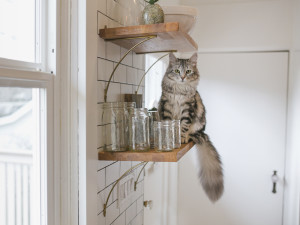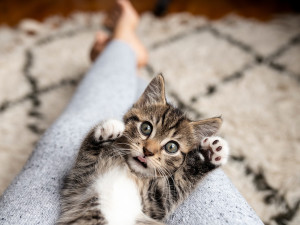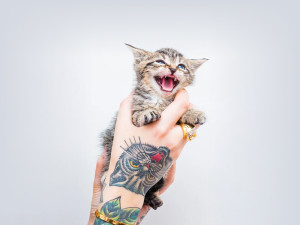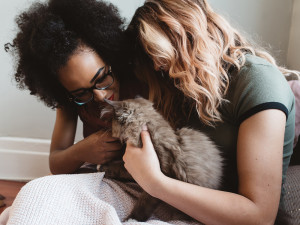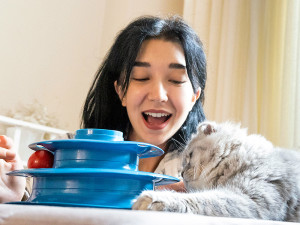5 Development Stages You Should Know When You Get a Kitten
What to expect from birth to 16 months.
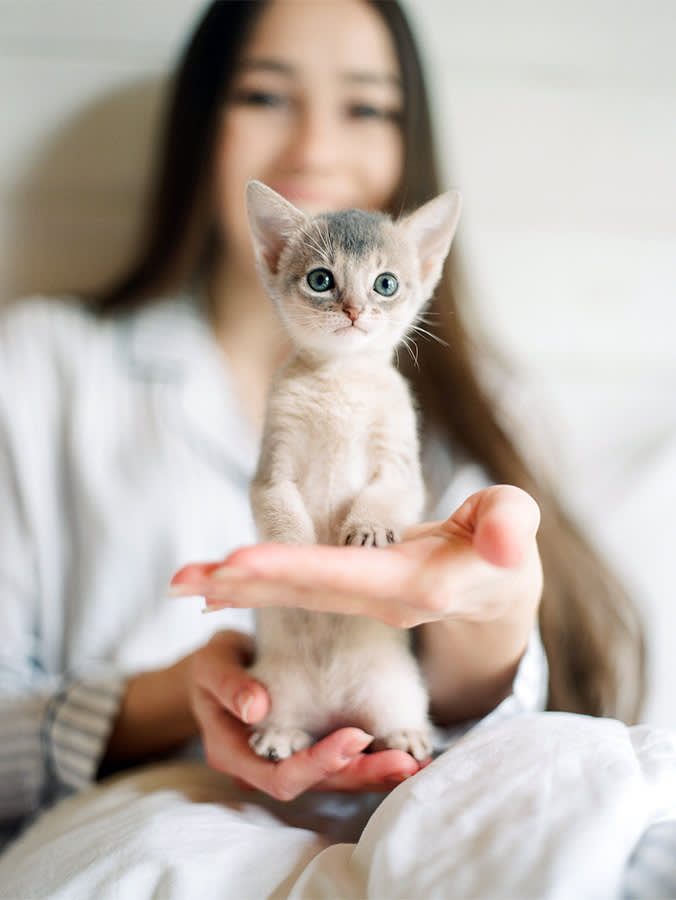
share article

Your pet wants you to read our newsletter. (Then give them a treat.)
Kittens can provide an endless supply of entertainment, snuggles, and social media-worthy silliness. But they can also be a source of bewilderment and confusion (How the heck did they jump upopens in a new tab to the top shelf?! or Wait, when do I need a litter box?).
If you’re considering adopting a kitten, or you’ve just brought one home (once they can safely be away from their momopens in a new tab), you are likely wondering, What now? Here are some kitten-health-development guidelines to help you out.
The colostrum window: Birth to 48 hours
Kittens enter the world with a complete lack of natural defenses and their immune systems are not prepared to fight common infections. This is where colostrum comes into play.
Colostrum, the initial milk produced by mothers after giving birthopens in a new tab, is rich in both nutrients and antibodies, which aid in combating infections. When kittens consume colostrum, they gain passive immunity and temporary protection from pathogens that their mom’s body has already learned to fight off.
Colostrum levels are highest during the first 12 hours after birth, and then slowly decrease over a few days. Kittens who miss out on colostrum are at a disadvantage early in lifeopens in a new tab compared to kittens who do.
1. Neonate Stage: Zero to two weeks
What to expect at the neonate stage
Newborn kittens are born toothless, with closed eyes and ears. They use scent and touch to navigate the space around them and are like little heat-seeking wrigglers. An umbilical cord remnant is present at birth but goes away within the first week. Newborn kittens depend on their mom for everything: food, hygiene, and warmth. Most of their time is spent nursing or sleeping.
What to do at the neonate stage
During this time, the queen (cat mom) is doing the heavy lifting. Cat parents should pay close attention to both mom and kittens to ensure that all are thriving during this time. Contact your vet if one or more kittens are not willing or able to nurse, or if mom shows no interest in caring for them.
Daily body weights may be recommended to make sure kittens are growing at the proper pace. A kitten’s body weight should double within the first two weeks of life. Although neonate kittens can fit in your palm, handling should be kept to a minimum.
2. Transition Stage: Two to four weeks
What to expect during the transitional stage
By this time, kittens’ eyes have opened, but their vision is still far from the impressive sharpness of adult cats. Their ear canals open and ear pinnae unfold. Kittens will get their first baby teeth — teeny tiny incisors and razor-sharp canines. Kittens will also start to walk and explore their surroundings, though they’re unlikely to go far. Expect to see a wide stance, uncoordinated steps, and a few kitten stumbles.
What to do during the transitional stage
Kitten parents can provide love and gentle cuddles. Interactions during this period can have long-lasting effects on a cat’s behavior and response to people — so make a good impression. Getting kittens used to a human touch during this phase is also rewarding, because it’s when most kittens start to purropens in a new tab.
Lots of introductions should be made during this stage. Introduce a small litter box that’s easy for kittens to get in and out of. Introduce toys to provide enrichment outside of littermates. If they haven’t met already, introduce your kitten to their vet so they can get a thorough check up and their first dewormer. At three to four weeks, consider introducing soft, mushy food to get the weaning process started.
3. Socialization Stage: Four to 12 weeks
What to expect during socialization
Kittens start to develop more mature traits at this stage. Their eye color changes from typical “kitten gray” to whatever color is coded within their genes. At eight weeks of age, kittens will have a full set of teeth. Weaning should be complete around this time. Male kittens’ testicles will start to descend around eight weeks, making it easier to determine sex within a litter. Kittens should also start grooming themselves. With their senses of smell, sight, and hearing more developed, kittens are more sure of themselves and more curious about their surroundings.
This is also when kittens form social bonds with their littermates, their human parents, and any other pets in the home. A kitten’s personality may start to mimic their parents, which has its pros and cons. Kittens may learn to use the litter box and look forward to meal time, just like mom. But there is a genetic component to kitten personality, so if either parent is fearful or aggressive, it can start to show up (even if that parent isn’t around).
Note: Kittens can be adopted (or fosteredopens in a new tab) as early as eight weeks, which is after they are weaned. However, many organizations recommend waiting until 10 to 12 weeks when kittens are fully weaned, better socialized, and have received vaccinations.
What to do during socialization
Kitten parents should make new experiences as positive as possible. Go slow with new experiences that may be overwhelming for young kittens, such as loud noises, car rides, and grooming. But don’t skimp on intentional handling — touch those ears and paws and open those mouths to get them used to the sensation. Focus on positive reinforcementopens in a new tab. Give them treats opens in a new tabafter nail trims, for coming when called, and for tolerating being picked up and cuddled (even if they asked for it).
At the start of this stage, their immune system is in flux; some antibodies from mom might still be around, but it's too soon to guarantee that a vaccine will be effective. So keep them protected from unvaccinated animals and safe from places like pet stores that may harbor a lot of pathogens.
Keep up with those vet check-ups. This is a period of frequent deworming and when flea and tick prevention should be started. Kittens should also receive their first FVRCP vaccine. This is a core vaccineopens in a new tab that protects against viral rhinotracheitis (feline herpes), calicivirus, and panleukopenia (feline distemper).
At 12 weeks of age, most kittens will be ready to receive their first rabies vaccinopens in a new tabe. This is also the time to talk to your vet about a spay/neuter plan. If healthy, many kittens can undergo spay/neuter surgery opens in a new tabas young as six to eight weeks of age.
4. Juvenile Stage: Three to six months
What to expect during the juvenile stage
During the juvenile stage, kittens are growing like weeds and are full of playful energy. They are prone to exploring, climbing, and wiggling in and out of small spaces. They also become adept hunters of toys and toes (don’t encourage toe-hunting, you’ll regret it). This is also when kittens will become more independent and develop an understanding of the hierarchy within their home, leading them to display more submissive or dominant behaviorsopens in a new tab.
What to do during the juvenile stage
Kitten-proof everything. This is when curious kittens are scaling screen doors, chewing on electrical cordsopens in a new tab, swatting at breakables, and climbing your tallest pieces of furniture. Minimize the chaos and destruction by keeping hazards out of reach. Make sure house plants are non-toxic to catsopens in a new tab. Provide lots of go-to activities and positive reinforcement for desired behaviors.
5. Adolescent Stage: Six to 16 months
What to expect during adolescence
Most cat parents won’t find a single stray baby tooth, but kittens will have lost their baby teeth and gained a full set of adult chompers around six to seven months of age. Because they’re still growing and developing, kittens will reach 80 percent of their adult weight by eight months of age and their full size by 12 months. After that, they will gain some muscle and many will gain some fat if attention is not paid to diet and exercise.
If not spayed or neutered, kittens will start to go through puberty. Females will have their first heat cycle and males may be tempted to wander in search of a mating partner. Territorial behaviors will begin: scent marking through urine spraying and rubbing the glands on their cheeks against objects and members of the household.
What to do during adolescence
Now is the time for kitten parentsopens in a new tab to set the stage for life-long good habits. Create a routine that promotes health and encourages good behavior.
Be predictable: Pets love predictability. Create a routine around meal time, grooming, and even cuddle time to give your cat some confidence.
Be clean: Scoop regularly and keep the litter boxes clean so your kitten is less likely to look elsewhere for places to eliminate.
Be proactive about dental health: Introduce gentle toothbrushingopens in a new tab to get kittens used to the sensation. Be sure to use cat-safe toothpaste.
Be food conscious: Kittens should be transitioned from a growth diet to a maintenance diet at 12 months. Tailor the amount fed to your cat’s needs and monitor for weight fluctuations.
Be playful: Cats are natural hunters. Provide lots of physical activity and mental stimulation to keep your cat happy and out of trouble.
References:
2021 AAHA/AAFP Feline Life Stage Guidelinesopens in a new tab
Association of Shelter Veterinarians Position Statement: Early Age Spay Neuteropens in a new tab
Feline Pediatrics: The First Four Weeks — 38th Annual OAVT Conference & Trade Show

Dr. Alycia Washington, DVM, MS
Alycia Washington, DVM, is a small animal emergency veterinarian based in North Carolina. She works as a relief veterinarianopens in a new tab and provides services to numerous emergency and specialty hospitals. Dr. Washington is also a children’s book author and freelance writer with a focus on veterinary medicine. She has a special fondness for turtles, honey bees, and penguins — none of which she treats. In her free time, Dr. Washington enjoys travel, good food, and good enough coffee.
Related articles
![A kitten laying on a persons lap with their paws in the air.]() opens in a new tab
opens in a new tab6 Things to Know Before Fostering a Cat
Ready to make a difference in a kitten’s life?
![A hand holding a kitten with a cat tattooed at the hand.]() opens in a new tab
opens in a new tabHeads Up: It’s Officially “Kitten Season”
Hannah Shaw, aka Kitten Lady, on how you can care for orphaned kittens this spring.
![cat getting a vaccine at the vet]() opens in a new tab
opens in a new tabYep, Kittens Need Vaccines (Even Indoor Ones)
A vet gets the facts straight.
![Two women, one with dark curly hair and deep skin and one with pink-blonde hair and lighter skin petting their grey cat]() opens in a new tab
opens in a new tabYes, You Should Spay/Neuter Your Cat. Here’s Why
A veterinarian breaks down how it keeps your pet healthy and curbs kitten overpopulation.
![Woman playing with her cat.]() opens in a new tab
opens in a new tabYour Cat Really Wants You to Play With Them—Here’s How
It’s the key to a happy cat.




